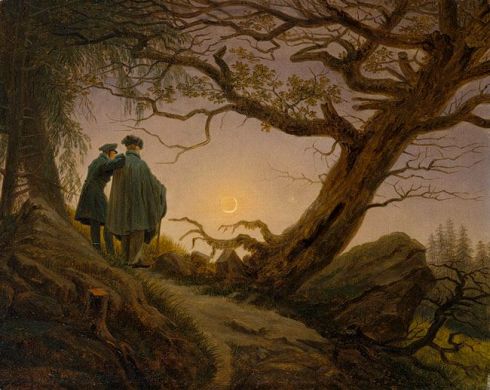How wonderful the little connections that pile up in the day to day. Blanco has long had an interest in the German expressionist painters of the early twentieth century, and was interested to learn, while reading about them the other day that Caspar David Friedrich, the great Romantic painter of lonely figures cast against majestic landscapes, was resurrected by the expressionists after falling into obscurity during the latter part of his life (when he was deemed ‘half-mad’) and after his death in 1840. (Friedrich was also taken up by the Nazis, as embodying the concept of heroic individualism, but he can hardly be blamed for that, and would, in any case – had he lived in the 1930s and 40s –have been incarcerated by them as a madman.)
Samuel Beckett had a great love for the visual arts, and – largely as a consequence of a love affair – during the 1920s and 1930s made several trips to Germany, followed by a longer trip in 1936-7, in which his diaries detail extensive visits to art galleries.
It is interesting therefore, to learn that the author of Waiting for Godot, considered by many to exemplify the most profoundly pessimistic vision of humanity in Western literature, and the absurd insignificance of mankind, should have identified a work by Caspar David Friedrich as the inspiration for his play. According to his biographer, James Knowlson (whose work is based on extensive interviews with Beckett himself) the writer told his friend, theatre critic Ruby Cohn, while looking at the 1824 painting Mann und Frau den Mond betrachend (Man and Woman observing the Moon) in Berlin: “this was the source of Waiting for Godot, you know.
However things are rarely as simple as they appear. Beckett, it seems, might have been confusing two paintings, according to Knowlson, because “at other times he drew attention of friends to Zwei Männer betrachten den Mond (Two men contemplating the Moon) from 1819.” As you can see, the two pictures are not wildly different (and there are various versions of both, it seems).
The point is, the image of the two tramps, Estragon and Valdimir gazing out over an alien landscape, makes a lot of sense in relation to these paintings.
But there is more.
Caspar David Friedrich is regarded as representing the apogee of the Romantic movement in the visual arts, setting down images of the Byronic hero, manfully facing down the forces of nature, the unknown, the abyss. Romanticism is precisely this: it arose at a period when the idea of God was being translated into the idea of nature. Poets set out on hikes into nature (Wordsworth and Coleridge tramping through Wales and the Lake District, Byron in the Alps writing Manfred . . . and with Shelley in Italy). Posh chaps didn’t walk in the countryside until then – no one did except the peasant farmer and the humble shepherd – and suddenly ‘Nature’ was opened up as this vast, wild, unexplored terrain (which in turn informs an understanding of the Romantic Imagination).
According to the art critic Robert Hughes, in an article on Friedrich,
“If there is one word for the mood of Friedrich’s pictures it is “longing”: the desire, never satisfied, to escape from the secular conditions of life into union with a distant nature, to be absorbed in it, to become one with the Great Other, whether that other is a mountain crag, an ancient but enduring tree, the calm of a horizontal sea, or the stillness of a cloud.”
How does this lead back to Beckett? Is Waiting for Godot, in essence, a play about longing? Longing for union with the godhead, with a distant nature, absorption with the Great Other, as conceived by a Romantic painter such as Friedrich?
Blanco can’t say, in fact is rather bowled over by all this and in need of a lie down. Any comments welcome.


Thanks for membership.
ReplyDelete